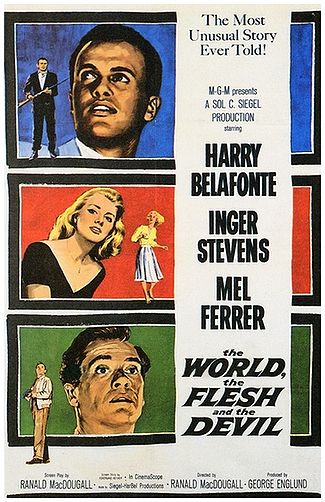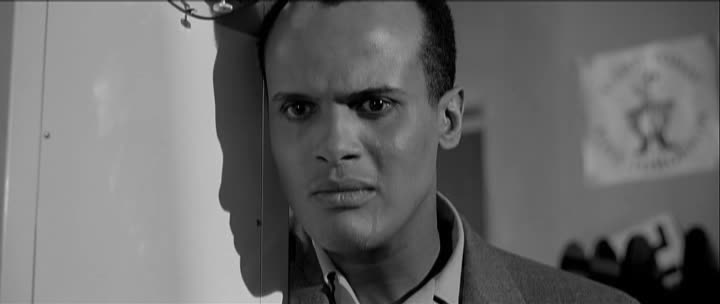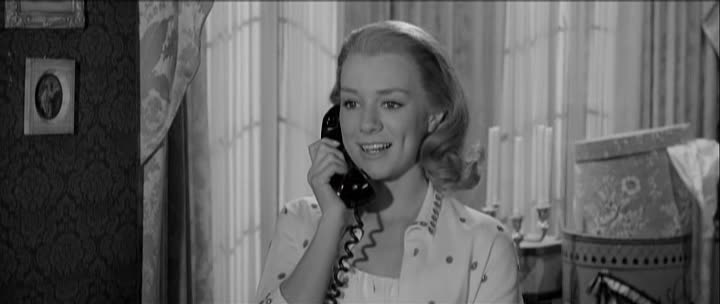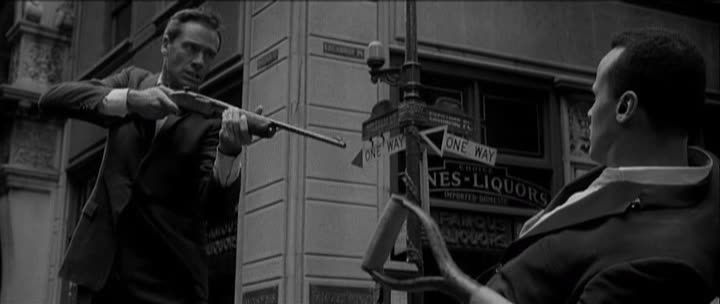The World, The Flesh, and The Devil (1959)

THE TRAILER
THE DIRECTOR
Ranald MacDougall
THE ACTORS
Harry Belafonte (Ralph Burton), Inger Stevens (Sarah Crandell), Mel Ferrer (Benson Thacker)
THE CAUSE
Nuclear War
THE STORY
“Ralph Burton is a miner who is trapped for several days as a result of a cave-in. When he finally manages to dig himself out, he realizes that all of mankind seems to have been destroyed in a nuclear holocaust. He travels to New York City only to find it deserted. Making a life for himself there, he is flabbergasted to eventually find Sarah Crandall, who also managed to survive. Together, they form a close friendship until the arrival of Benson Thacker who has managed to pilot his small boat into the city’s harbor. At this point the tensions rise between the three, particularly between Thacker, who is white and Burton, who is black.” – taken from synopsis on the film’s IMDb page by garykmcd.
THE RUNDOWN
“Last Man on Earth” stories are probably the most common type of framework for a doomsday story. There’s an instant appeal to this sort of story because we get to experience a world with a character who is generally as clueless as the audience itself. We see what they see and grow to sympathize with this character so much that we experience a type of Stockholm syndrome. Even if this character does something despicable, the audience will be on their side because we feel close to our lone protagonist. But while this element is oft-used to get an audience to side with a bad character, its rarely used to help an audience overcome preconceived notions about a person.
The World, The Flesh, and The Devil concerns Ralph (Harry Belafonte); a miner who is trapped in a cave-in at the opening of the film. Ralph is trapped for at least five days before managing to dig himself out. When he emerges, he does so to a world completely devoid of life. He finds out that an enemy combatant released a radioactive isotope into the Earth’s atmosphere, the reason he survived was because it has a half-life of only 5 days. He takes a car and goes to New York City in hopes of finding someone but is still apparently alone. He slowly begins going crazy from isolation and loneliness when Sarah (Inger Stevens) makes herself known. Ralph and Sarah have a definite romantic chemistry but society’s prejudices overshadow their feelings for one another even in a world where social norms are irrelevant.
Looking back, this movie doesn’t seem that impressive: it’s a movie about a black man and a white woman falling in love in a post-apocalyptic world, so what? But this movie was released in 1959, America had only taken baby steps toward recognizing African Americans as actual human beings and the thought of releasing a major motion picture with an African American lead, let alone one featuring an interracial romantic pairing, was all-but unthinkable. You can see this in the trailer above, which makes Mel Ferrer out to be the lead and Harry Belafonte is portrayed largely as a savage. The film was a box-office flop, due in some part to boycotts in the South and at least one theater pulling the movie to avoid potential violence. The World, The Flesh, and The Devil was a giant middle finger extended at racists made in an era where one didn’t even have to really try to be racist.

This movie has hubris like you wouldn’t believe, even though it doesn’t feel like it now. The relationship between Ralph and Sarah is built up naturally, it’s not hard to root for this couple (particularly after having spent the first third of the movie isolated with Ralph) but just when something is about to happen the rug is pulled away.
Sarah tells Ralph that it would be “easier” if she moved into his building (he has hooked a generator up to the building that she lives in as well as his own so they can have electricity.) He declines her offer and when she asks why he tells her “People might talk.” Much is made of Ralph adhering to a social construct that no longer applies to him and it really comes to a head in a scene, where Sarah asks him to cut her hair. It’s at once a social commentary and a scene of sexual tension as Ralph can be seen trying to overcome his attraction for Sarah due to an ingrained understanding that the pursuance of a white woman would be trouble for him. There’s also a great scene where Ralph tears Sarah down about her white privilege and how she doesn’t need to think about it; I would have loved to see how many stupid assholes that pissed off back in the day.
Ultimately the two do grow closer even through Ralph makes a token attempt to hold her at arm’s length. But just as they finally begin to admit that social conventions are no longer relevant, the movie delivers its second gut punch. Ralph continually monitors radio equipment for any signs of life and one day he gets a response in French. The moment of realization as Ralph’s look of elation at realizing that he and Emma aren’t alone in the world crumbles into one of despair as he realizes what that means for them is probably the greatest dramatic moment of the movie. And The World, The Flesh, and The Devil isn’t done tormenting Ralph yet.
Days after Ralph effectively “breaks up” with Sarah, a boat is seen coming down the river and the deliberate course it sets can only mean that its being controlled by someone. That someone is Ben, who is near death when they find him, but is then nursed back to health by Ralph. Ralph “gets out of Ben’s way” in regards to Sarah, who is distressed by this and by Ben’s blatant advances. Ben is upset by Sarah’s love of Ralph and relative indifference to him so he grows ever more intolerant of Ralph’s continued existence.

I have to commend the movie’s agenda when it comes to race, but I do feel the need to chide its sexual politics a little. Now, for a movie in 1959, The World, The Flesh, and The Devil handles Sarah pretty well. Yes, she’s overtly girly and a tad materialistic but she’s not content to be owned by anyone and neither Ralph nor Ben are going to tell her what to do. However, Sarah’s obsession with getting married makes her seem extremely shallow and the way she seems to be having a harder time choosing between Ralph and Ben as Ben’s behavior gets skeezier (culminating in a scene which you can see in the trailer above) is cringe-worthy in the highest order.
Of course, the problematic nature of Sarah’s and Ben’s character really comes to prominance in the film’s finale. SPOILERS START HERE AND END AT THE NEXT PICTURE. In a way I admire the way the movie handles Ben. It would have been far too easy to turn him into a sneering hateful good old boy (that may have been what the character would have been if that character description didn’t describe a large section of the country at the time) but Ben isn’t racist, at least not overtly.
Ben seems to have a respect for Ralph and doesn’t ever call him names or cut him down because of his race, his prejudice is more insidious than that. He sees Ralph as an obstacle between him and Sarah and though his race isn’t the main reason why that pisses him off, it’s a factor. That amount of subtlety was not even close to necessary in 1959 when “Colored” was an acceptable nomenclature, but I appreciate that they went for it anyway. His idea of Sarah seems to be one of ownership as well, it’s clear he feels entitled to her and says things to that effect at several points. Ben describes himself as an idealist before the fall but its clear that a world where his white male privilege isn’t in effect at all times is driving him all kinds of nuts. He tells Ralph that the problem they have is that there are two men left and only one woman and later mentions to Sarah how easy it would be to rape her, when she stands up to him about that he declares war on Ralph and begins shooting at him.
Ralph goes to fight back but takes pause when he sees an inscription at the United Nations Plaza of a bible verse “They shall beat their swords into plowshares. And their spears into pruning hooks. Nation shall not lift up sword against nation. Neither shall they learn war any more.” He throws down his gun and tells Ben he doesn’t care anymore, and Ben refuses to shoot him if he’s not going to fight back. Ben storms off as Sarah arrives and though Ralph tells her he intends to leave and go rebuild the world she asks him to take her with him and in a tender moment the two join hands and in a better world the movie ends there.
You see, there are some hurdles that Ralph and Sarah couldn’t overcome, and the racism of the world their story is being told to was one such thing. There was a lot of back and forth between the studio and the writers, directors, and actors over whether Bellafonte and Stevens should kiss. Ultimately the studio won out so a haircut and a hand-hold are all we got, but that’s not nearly as despicable as the other change to the story. Now, I will first admit that I don’t have a super reliable source on this so I will say to take this part with a grain of salt, but as I understand it the script originally called for Ben to storm off and leave Ralph and Sarah to be together, but the studio wasn’t quite ballsy enough to confront the anger of a large amount of white people having to deal with the concept of a black man and a white woman consummating their relationship. After Ralph and Sarah join hands, she calls to Ben to come join them and the three walk down the street as we zoom out and the music swells, the words “The Beginning” appear on the screen.
The ending isn’t as bad as it could have been, but come on. I do admire the concept of the three rising above their prejudices and bullshit and deciding to press on, but Ben is a shithead. He tried to kill Ralph, threatens to rape Sarah, and just acts like a stupid possessive asshole for about 20 of the 30 minutes he’s even in the movie. I’m okay with accepting him back into the fray as a gesture that things are going to change but they should handle it better, he at least deserves a reprimand; a slap on the face and a kick in the ass. Not to mention the fact that this ending has invited decades of debate on whether this means that Ben and Ralph are now brother-husbands or whatever. It completely undermines the message at large of the movie and that’s kind of bullshit.

While racism is a main theme, it’s not the only one. The title alludes to the purpose of the narrative: The world, the flesh, and the devil are concepts from Christian theology, seen as a sort of evil trinity in opposition to the father, the son, and the holy spirit. The three characters do certainly embody materialism, lust, and general evil thoughts at different points but there seems to also be a sort of attempted parable at assigning one attribute to each character, with Ralph representing The World (because of his obsession with rebuilding a world that killed itself, and never had a place for him in the first place), Sarah representing The Flesh (because it was the 1950s and even forward-thinking films had some ugly hang-ups), and Ben representing The Devil (because he’s a dick.) These assignments work but they’re a bit too simplistic and the movie has a great deal more subtlety than that.
The World, The Flesh, and The Devil was ahead of its time in 1959 and though it is largely dated, much of its message still applies today where studios still don’t have the balls to portray an interracial couple where the man is a non-Will Smith African American. It has its share of flaws and logical inconsistencies (where are all the corpses?) and the second half isn’t nearly as captivating or interesting as the first, but it’s beautifully shot and acted with a haunting atmosphere and a message from which we could all still learn a thing or two.
THE SHILL
The World, The Flesh, and The Devil can be obtained from Amazon as a DVD or viewed on Instant.
NEXT TIME ON DOOMSDAY REELS
“Gentlemen, when I want your opinions, I will give them to you!”